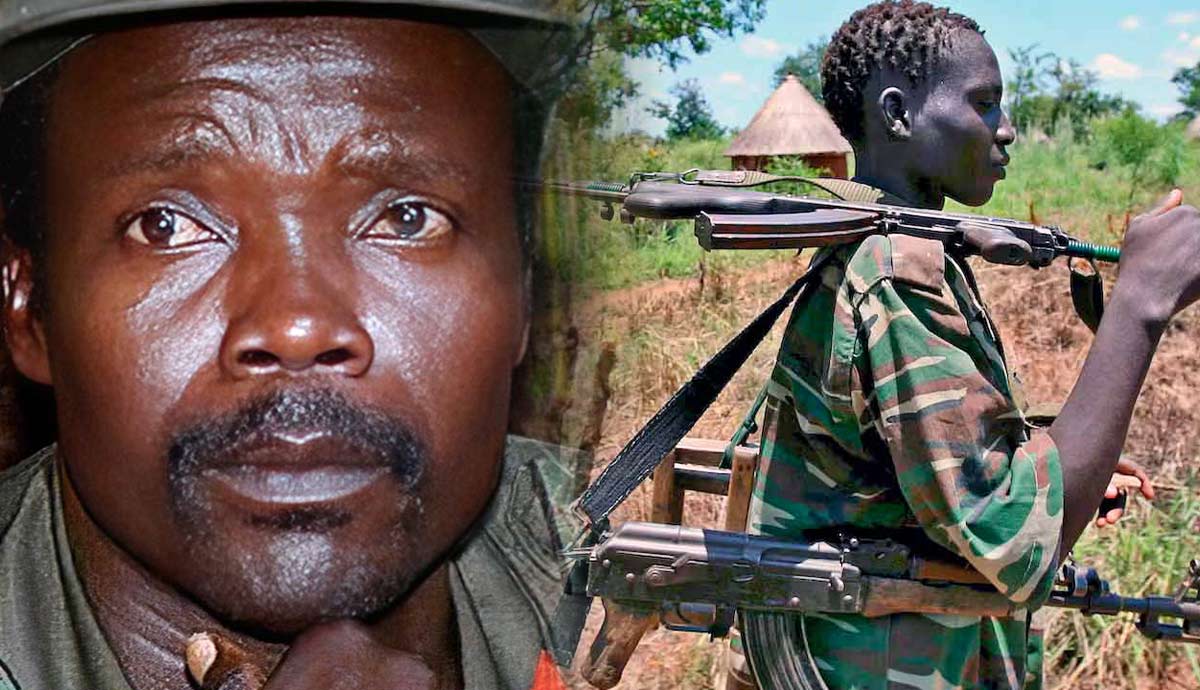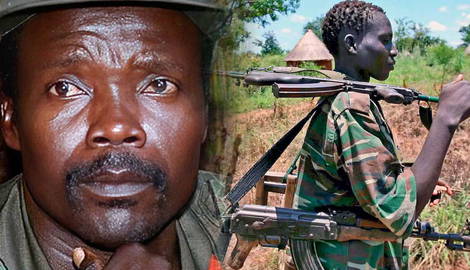
Uganda is known for the horrors inflicted by its former leader Idi Amin, but after his exile and death, the country had very little time to enjoy any form of peace. In 1987, a new organization sprang up in the north of Uganda. Initially formed to champion the cause of people disenfranchised by the ethnically different authorities in Uganda, the Lord’s Resistance Army (LRA) soon turned to using methods of insane brutality, committing gross acts in violation of human rights inspired by an almost inhuman religious zeal. At the center of this organization was (and possibly still is) the enigmatic and terrifying character Joseph Kony, who is believed by his followers and his enemies to be possessed by spirits.
The Early Life of Joseph Kony

Born in 1961 to the Acholi, a Nilotic people of South Sudan and northern Uganda, Joseph Kony was either the youngest or second youngest of six children. His family was very religious, and Kony spent much of his youth as an altar boy. From a young age, he already showed a predisposition for violence when arguing with his siblings, resorting to physical means when frustrated. In 1976, he dropped out of school at the age of 15.
The political dynamic of Uganda at the time would be shaped by conflict. It was in this context that Joseph Kony would thrive and rise to prominence. The source of tension was the ethnic and cultural divide between the Bantu south and Nilotic north. In 1980, after losing the national election to Milton Obote, Yoweri Museveni (from Uganda’s south) started a civil war. The Ugandan Bush War, as it came to be known, lasted until 1986, when Museveni’s National Resistance Movement achieved victory, and Museveni became the new president. This came six months after the leader of the Uganda National Liberation Army (the government’s military), Tito Okello, launched a successful coup d’état, removing Milton Obote from office and assuming the position of president himself.

During the Ugandan Bush War, Museveni’s forces had committed numerous war crimes, including mass executions, burning of settlements and villages, rape, shooting of livestock, and even genocide. Museveni’s victory did not bring an end to the war.
This prompted the creation of the Holy Spirit Movement (HSM) led by self-styled prophet Alice Lakwena, who believed she was possessed by spirits. The HSM was just one of many rebel groups that sprang up to fight against the government of Museveni, but it inspired Joseph Kony to start his own movement. Lakwena was arrested in 1987 after moving her forces into Kenya, and Kony’s Lord’s Resistance Army quickly picked up the pieces of her movement.
Like Alice Lakwena, Joseph Kony saw himself as a prophet through which spirits worked. With his messianic aura, his followers revere(d) him as a religious figure and were prepared to commit the worst atrocities in his name. And like Lakwena, Kony used oil to draw crosses on himself and his combatants, believing it would be divine protection against bullets.
Believing in his own spiritual mission, Kony once told reporters, “We are fighting for God’s Ten Commandments. We are fighting to eradicate evil.”
The Lord’s Resistance Army Gains Strength

In the first few years after its creation, the LRA made small raids and attacks on villages and towns, slowly gaining the attention of the government, which responded in 1991. “Operation North” sought to dry up LRA recruitment and provide resistance to the LRA by arming local villagers with bows and arrows.
Ultimately, the operation was a failure, but it led to talks between Kony and the government. Negotiations dragged on until 1994 when Kony, upset with the direction the talks had taken and suspicious of the government’s motives, broke off the negotiations and resumed his rebel activities.
Meanwhile, the Ugandan government had been supporting the South Sudanese rebels in their fight against the government of Sudan. In retaliation, the Sudanese government gave its support to the LRA, and the fighting continued, with brutal crimes being committed by both sides. The LRA, however, became infamous for its methods. Victims of the LRA had their lips, ears, or other body parts chopped off for little or no reason. Mass executions, mass rape, slavery, and pressing children into service became common methods employed by Kony’s followers in their struggle to topple the Ugandan government.

On April 20, 1995, the LRA took part in the Atiak Massacre, one of the most notable events of the war. The village of Atiak, in the north of Uganda, comprised people from the Acholi ethnicity, from which the LRA demanded support. Three hundred LRA fighters entered the village and declared that the villagers had refused to support the LRA. Young boys and girls were handpicked to be used as child soldiers and sex slaves, while the rest of the villagers, around 300 people, were executed by gunfire.
The following year, the LRA made international news by committing what became known as the Aboke Abductions. From St. Mary’s College boarding school, 139 female students were abducted on the night of October 10, 1996. Following the gallant actions of Sister Fassera, an Italian nun, 109 of the girls were released. The fate of the other 30 girls was miserable, but most of them escaped their tormentors in the years that followed. A few of them died in captivity, having been beaten to death.

In the following years, the violence continued, and more war crimes were committed. By the early 2000s, the LRA had even fallen out of favor with the Sudanese government (National Islamic Front). In 2002, with Sudanese permission, the Ugandan government launched a campaign targeting LRA bases in southern Sudan. The LRA responded predictably, attacking refugee camps in southern Sudan and northern Uganda, massacring hundreds of civilians.
Seeking an end to the violence, international organizations attempted to broker peace deals between the LRA and the Ugandan government, but Kony spurned them all, including the Carter Center and Pope John Paul II. In 2006, however, an agreement was reached. The LRA agreed to relocate to an area in the Democratic Republic of the Congo, which the Ugandan government promised not to attack. Kony accepted the deal and moved thousands of soldiers into the remote Garamba National Park. In 2008, however, the agreement was broken.
Operation Lightning Thunder and Aftermath

Joseph Kony had secretly been recruiting and rearming his troops, and in June, LRA soldiers launched an attack in South Sudan, killing 14 soldiers and nine civilians. In response to this surprise attack, the governments of Uganda, South Sudan, and the Democratic Republic of the Congo agreed to respond by attempting to end the LRA threat by launching Operation Lightning Thunder. With an agreement signed by George W. Bush, the US provided financial, technical, and logistics support and provided expert planning for the operation.
In December 2008, the Armed Forces of the Democratic Republic of the Congo, the Uganda People’s Defence Force, and the Sudan People’s Liberation Army launched their attack. A report issued by the Ugandan government claimed the combined forces had successfully attacked the main body of the LRA, including Kony’s camp. It further claimed that 70% of the LRA camps had been destroyed in the operation.
The LRA, however, was not destroyed, and attacks continued with brutal reprisals. The LRA further spread through parts of the DRC, and the Central African Republic, increasing their attacks. Small-scale attacks became more frequent, happening every day. Thousands of people were killed or abducted, while hundreds of thousands were displaced by the LRA, a force of only a few hundred terrorists.
Since 2012, an African Union military force of thousands of soldiers has operated in the affected areas in a quest to find Joseph Kony and bring him to justice.
Kony 2012

The plight of the affected nations and the terror of Joseph Kony and the Lord’s Resistance Army was brought to widespread public attention with the release of a 30-minute documentary film. Released on the internet, Kony 2012 (2012) was a massive success, prompting many governments to take significant action to track down Joseph Kony and to provide assistance to those affected by the LRA’s brutality. It was also the first film on Youtube to reach 1 million views.
Joseph Kony & The LRA Now?

Despite armies being formed to hunt down Joseph Kony, he remains at large. Hundreds of millions of dollars have been spent over 20 years in order to find him and bring him to justice, but so far, there has been little success.
In 2015, high-ranking LRA leader Dominic Ongwen surrendered and was convicted, but the LRA continues to operate, albeit at a much lower level than in the past. Their targets are generally in the vicinity of poorly protected border areas where they raid for supplies and new recruits.
Nevertheless, the years of brutality have left their mark on Uganda and the surrounding countries. Millions have suffered as a result.

The figure of Joseph Kony is one that represents a terrorist and a cult leader to his enemies, but an icon of religious properties to his followers. If he is alive, he lives as a man who has defied extremely powerful enemies and still resists, and if he is dead, he exists as a martyr to his cause.
It is likely we’ll never know much about this secretive character. We don’t even know whether he’s alive or dead. And those who do know are likely to shoot those searching for answers.
Despite this danger, a DW article reported in 2022 that an LRA fighter claimed Kony was living in the Darfur region in Sudan and that the LRA was tired and close to complete defeat after years of being chased and hounded. The veracity of this claim, however, is yet to be verified.










